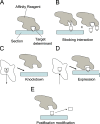Quantitative assessment of specificity in immunoelectron microscopy
- PMID: 20458060
- PMCID: PMC2942744
- DOI: 10.1369/jhc.2010.956243
Quantitative assessment of specificity in immunoelectron microscopy
Abstract
In immunoelectron microscopy (immuno-EM) on ultrathin sections, gold particles are used for localization of molecular components of cells. These particles are countable, and quantitative methods have been established to estimate and evaluate the density and distribution of "raw" gold particle counts from a single uncontrolled labeling experiment. However, these raw counts are composed of two distinct elements: particles that are specific (specific labeling) and particles that are not (nonspecific labeling) for the target component. So far, approaches for assessment of specific labeling and for correction of raw gold particle counts to reveal specific labeling densities and distributions have not attracted much attention. Here, we discuss experimental strategies for determining specificity in immuno-EM, and we present methods for quantitative assessment of (1) the probability that an observed gold particle is specific for the target, (2) the density of specific labeling, and (3) the distribution of specific labeling over a series of compartments. These methods should be of general utility for researchers investigating the distribution of cellular components using on-section immunogold labeling.
Figures


Similar articles
-
Multiple-labelling immunoEM using different sizes of colloidal gold: alternative approaches to test for differential distribution and colocalization in subcellular structures.Histochem Cell Biol. 2011 Mar;135(3):317-26. doi: 10.1007/s00418-011-0788-0. Epub 2011 Feb 16. Histochem Cell Biol. 2011. PMID: 21327857
-
Analysis of specificity in immunoelectron microscopy.Methods Mol Biol. 2014;1117:315-23. doi: 10.1007/978-1-62703-776-1_14. Methods Mol Biol. 2014. PMID: 24357369
-
Developments in cell biology for quantitative immunoelectron microscopy based on thin sections: a review.Histochem Cell Biol. 2008 Aug;130(2):299-313. doi: 10.1007/s00418-008-0451-6. Epub 2008 Jun 14. Histochem Cell Biol. 2008. PMID: 18553098 Free PMC article. Review.
-
Post-embedding double-gold labeling immunoelectron microscopic co-localization of neurotransmitters in the rat brain.Med Sci Monit. 2001 Mar-Apr;7(2):188-200. Med Sci Monit. 2001. PMID: 11257721
-
Mapping the distributions and quantifying the labelling intensities of cell compartments by immunoelectron microscopy: progress towards a coherent set of methods.J Anat. 2011 Dec;219(6):647-60. doi: 10.1111/j.1469-7580.2011.01438.x. Epub 2011 Oct 17. J Anat. 2011. PMID: 21999926 Free PMC article. Review.
Cited by
-
Using Diatom and Apicomplexan Models to Study the Heme Pathway of Chromera velia.Int J Mol Sci. 2021 Jun 17;22(12):6495. doi: 10.3390/ijms22126495. Int J Mol Sci. 2021. PMID: 34204357 Free PMC article.
-
Antibodies for immunolabeling by light and electron microscopy: not for the faint hearted.Histochem Cell Biol. 2014 Oct;142(4):347-60. doi: 10.1007/s00418-014-1263-5. Epub 2014 Aug 24. Histochem Cell Biol. 2014. PMID: 25151300 Free PMC article. Review.
-
From gross anatomy to the nanomorphome: stereological tools provide a paradigm for advancing research in quantitative morphomics.J Anat. 2015 Apr;226(4):309-21. doi: 10.1111/joa.12287. Epub 2015 Mar 9. J Anat. 2015. PMID: 25753334 Free PMC article.
-
Altered Basal Autophagy Affects Extracellular Vesicle Release in Cells of Lagotto Romagnolo Dogs With a Variant ATG4D.Vet Pathol. 2020 Nov;57(6):926-935. doi: 10.1177/0300985820959243. Epub 2020 Oct 5. Vet Pathol. 2020. PMID: 33016245 Free PMC article.
-
Multiple-labelling immunoEM using different sizes of colloidal gold: alternative approaches to test for differential distribution and colocalization in subcellular structures.Histochem Cell Biol. 2011 Mar;135(3):317-26. doi: 10.1007/s00418-011-0788-0. Epub 2011 Feb 16. Histochem Cell Biol. 2011. PMID: 21327857
References
-
- Abramoff MD, Magelhaes PJ, Ram SJ (2004) Image processing with ImageJ. Biophotonics International 11:36–42
-
- Andjelkovic M, Alessi DR, Meier R, Fernandez A, Lamb NJ, Frech M, Cron P, et al. (1997) Role of translocation in the activation and function of protein kinase B. J Biol Chem 272:31515–31524 - PubMed
-
- Bendayan M (1981) Ultrastructural localization of nuclei acids by the use of enzyme-gold complexes. J Histochem Cytochem 29:531–541 - PubMed
-
- Bendayan M (2000) A review of the potential and versatility of colloidal gold cytochemical labeling for molecular morphology. Biotech Histochem 75:203–242 - PubMed
MeSH terms
LinkOut - more resources
Full Text Sources

